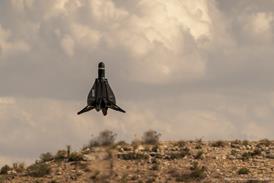Tim Ripley
First details of new UK defence spending plans are beginning to emerge during Farnborough week, bringing mixed news for defence and aerospace contractors. Chancellor of the Exchequer Gordon Brown announced headline increases to bring the defence budget to almost £25 billion by 2000, with Defence Secretary Geoff Hoon saying the procurement spending headline figure is to increase by £1.25 billion. The small print of the announcement, however, makes it clear that the Treasury has driven a hard bargain with Hoon's ministry and £750 million in procurement savings are required, along with the delivery of 3% "efficiency" savings each year. At least £600 million also has to be raised from the sale of assets. Complex financial mechanisms are in place to force Hoon to make savings before "additional" money will be released for new projects. Ministry of Defence spokesmen say there are no plans for a "global" announcement of where the extra procurement money will be spent, but ministers have said they want to rectify equipment deficiencies identified during the Kosovo conflict and to complete Strategic Defence Review equipment buys. This is believed to include purchase of GPS guided bombs to allow the RAF to attack targets in bad weather, Raytheon AGM-65 Maverick air-to-ground missiles, new reconnaissance systems and satellite communications. The new money is also expected to fund the leasing of four Boeing C-17 Globemaster strategic airlifters.
A package of savings 'options' has also been put together, which are understood to include the cancellation of the Eurofighter's internal cannon, delaying the first buy of Eurofighter spares and deferring Brimstone integration on the aircraft. Studies and Technology Demonstrator Programmes associated with the FOA (Future Offensive Aircraft) requirement are also being 'rescoped', while DERA's budget for support and risk provision for the troubled BAE Systems Nimrod MRA Mk 4 programme is being reduced.
The options approved also include a host of measures which will affect the present frontline fleet. Two BAe Nimrod MR Mk 2s are to be removed from service, further Lockheed Martin C-130J deliveries are to be delayed, and the VC 10 fleet is to be further îrationalised'. Funding for the Panavia Tornado F.3 is to be reduced, the budget for HOTAS provision will be deferred, a re-profiling of funding on F. 3 electronic counter-measures with the reduction of 5 Squadron, which will become a post-OEU (Operational Evaluation Unit) tactical development unit. The completion of ASRAAM (Advanced Short-Range Air to Air Missile) integration on the Jaguar has been cancelled. Successor identification-friend-or-foe (IFF) (SIFF) will not be integrated on the BAE Systems Hawks used by the Red Arrows, even though these have a frontline 'war role' as point-defence aircraft. Other cuts affecting the RAF include the cancellation of two planned additional Airborne Stand-off Radar (ASTOR) ground stations, and a number of changes to the Alenia Marconi Systems Brimstone missile programme. Its in-service date is to be delayed by one year and the number of rounds procured is being reduced by 25%. The Army Air Corps has also had its Agusta A109 replacement cancelled along with "integration of the CRV7 rocket with the RTM engine" on the WAH-64. The Royal Navy's BAe Sea Harriers will now not gain a SIFF interrogator, and ASRAAM funding for the aircraft is being "re-profiled". Planned integration of a 360deg radar on the GKN Westland Lynx HMA8, already a feature of export Super Lynxes, is being revised.
Source: Flight Daily News























